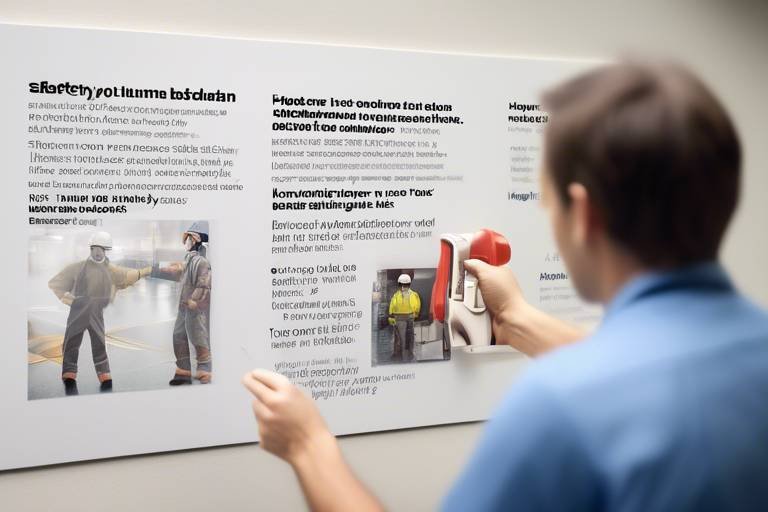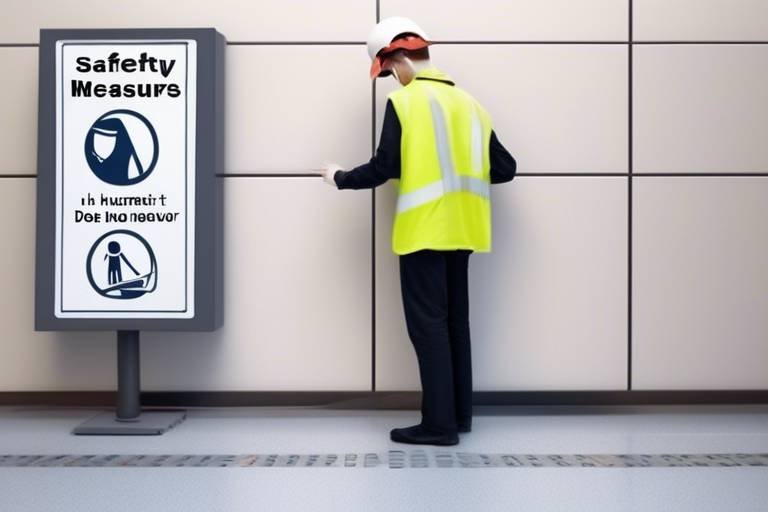Shaping Safety Standards through Insights into Human Behavior
In today's fast-paced world, the importance of safety in the workplace cannot be overstated. As industries evolve, so too must our understanding of how human behavior influences safety standards. It’s not just about having the right equipment or protocols in place; it’s about recognizing that the individuals within an organization are the heart of any safety program. Their actions, decisions, and even their perceptions of risk play a pivotal role in shaping safety outcomes. This article delves deep into the intricate relationship between human behavior and safety standards, exploring how insights into this relationship can lead to more effective practices and improved outcomes for both employees and organizations.
When we talk about workplace safety, we often focus on regulations, machinery, and environmental factors. However, it’s crucial to shift our lens towards the people who operate within these environments. Every day, employees make choices that can either enhance or jeopardize safety. For instance, consider a construction site where workers are tasked with wearing helmets. If an employee chooses to forgo this safety gear, it’s not just a lapse in judgment; it’s a behavior that can lead to catastrophic consequences. Understanding these behaviors, the motivations behind them, and the contexts in which they occur can significantly impact how we develop safety protocols.
Behavioral safety programs are designed to address the human element of safety by focusing on the actions and attitudes of employees. These programs aim to create a culture of safety that extends beyond mere compliance with rules. The objectives of these programs are clear: reduce accidents, enhance safety awareness, and promote a proactive approach to safety. Implementation strategies can vary widely, but they often include training sessions, safety observations, and regular feedback loops. The positive effects of these programs are evident; organizations that invest in behavioral safety often see a marked decrease in workplace incidents and a shift towards a more safety-oriented culture.
To ensure the success of behavioral safety programs, several key components must be integrated:
- Training: Providing employees with the knowledge and skills necessary to recognize and mitigate risks.
- Observation: Actively monitoring behaviors to identify unsafe practices and opportunities for improvement.
- Feedback Mechanisms: Establishing channels for constructive feedback that encourage safe behaviors and discourage risky actions.
These elements work together to create a comprehensive approach that not only addresses the immediate safety concerns but also fosters a long-term commitment to safe practices among employees.
Training plays a vital role in shaping safety behaviors. It’s not enough to simply tell employees what they should do; we need to engage them in a way that resonates. Tailored training approaches, such as hands-on workshops, simulations, and role-playing scenarios, can be particularly effective. These methods allow employees to experience real-life situations in a controlled environment, helping them understand the consequences of their actions and the importance of adhering to safety protocols.
Observation is another critical piece of the puzzle. By monitoring employee behaviors, organizations can identify patterns that may lead to unsafe practices. However, it’s not just about watching; it’s about providing constructive feedback that reinforces positive behaviors. Effective feedback should be timely, specific, and actionable, allowing employees to understand exactly what they did well and where they can improve. This approach not only enhances safety compliance but also builds trust between employees and management.
To evaluate the effectiveness of behavioral safety initiatives, organizations must establish clear metrics. These can include tracking incident rates, conducting employee surveys, and analyzing safety audit results. By regularly assessing these outcomes, organizations can gain valuable insights into the success of their programs and make necessary adjustments. This iterative process ensures that safety measures remain relevant and effective in addressing the ever-changing dynamics of the workplace.
Understanding the psychological factors that influence safety behavior is crucial for developing effective safety programs. Motivation, perception, and risk assessment are key elements that can significantly impact how employees approach safety in their daily tasks. For instance, an employee’s motivation to adhere to safety protocols may stem from personal values, peer influences, or organizational culture. By fostering an environment that promotes positive motivations, organizations can enhance compliance and reduce risky behaviors.
Motivation can be categorized into intrinsic and extrinsic factors. Intrinsic motivation refers to internal drives, such as personal pride or a sense of responsibility, while extrinsic motivation involves external rewards, such as recognition or bonuses. Both types of motivation play a role in safety compliance, and understanding how to leverage these can lead to better adherence to safety protocols.
Finally, the perception of risk is a critical factor in safety behavior. How individuals assess risks can vary widely based on their experiences, training, and even their emotional state at any given time. For example, a worker who has witnessed a near-miss incident may become overly cautious, while another who has never encountered a safety issue may underestimate potential dangers. By addressing these perceptions through targeted training and open discussions, organizations can help employees make more informed decisions regarding safety.
Q: What are behavioral safety programs?
A: Behavioral safety programs focus on understanding and influencing the actions and attitudes of employees to enhance workplace safety.
Q: How can organizations measure the effectiveness of their safety programs?
A: Organizations can track incident rates, conduct employee surveys, and analyze safety audit results to evaluate the success of their safety initiatives.
Q: Why is understanding human behavior important for safety?
A: Understanding human behavior helps organizations develop more effective safety protocols by addressing the motivations and perceptions that drive employee actions.

The Importance of Human Behavior in Safety
Understanding human behavior is crucial for enhancing safety protocols in any industry. Why? Because safety is not just about rules and regulations; it’s about the people who are expected to follow them. Every day, individuals make choices that can either uphold or undermine safety standards. For instance, consider a construction worker who decides to skip wearing a helmet because "it’s too hot." This single decision can have dire consequences, not just for the individual but for the entire team. Therefore, recognizing how human behavior impacts safety is essential for creating a safer workplace.
Human behavior in safety contexts can be influenced by various factors, including personal beliefs, past experiences, and even the work environment itself. When employees feel empowered and engaged, they are more likely to adhere to safety protocols. Conversely, if they feel disengaged or undervalued, they may neglect safety measures. This dynamic highlights the importance of fostering a culture where safety is prioritized and valued by everyone in the organization.
Moreover, it's essential to understand that safety compliance is not merely about following orders; it’s about the psychological and social influences that drive behavior. For example, if a workplace promotes a strong safety culture, employees are more likely to feel responsible for their own safety and the safety of their peers. This sense of responsibility can lead to proactive behaviors, such as reporting unsafe conditions or suggesting improvements to safety practices.
To illustrate the impact of human behavior on safety, consider the following table that summarizes key behavioral influences:
| Behavioral Influence | Impact on Safety |
|---|---|
| Personal Motivation | Increases adherence to safety protocols |
| Peer Influence | Encourages a collective commitment to safety |
| Management Support | Fosters an environment where safety is prioritized |
| Training and Education | Enhances awareness and understanding of safety practices |
In summary, human behavior is at the core of safety standards. By understanding the motivations and actions of individuals, organizations can develop more effective safety protocols. This understanding can lead to improved training programs, enhanced communication strategies, and ultimately, a safer working environment for everyone. So, the next time you think about safety, remember that it’s not just about the rules; it’s about the people who follow them.

Behavioral Safety Programs
Behavioral safety programs are pivotal in shaping a culture of safety within organizations. By focusing on the actions and decisions of individuals, these programs aim to mitigate risks and enhance overall safety standards. The essence of these programs lies in understanding that safety is not solely about adhering to rules and regulations; it’s about fostering a mindset where every employee feels responsible for their own safety and that of their colleagues. Imagine a workplace where everyone is actively engaged in promoting safety—this is the reality that effective behavioral safety programs strive to create.
One of the primary objectives of behavioral safety programs is to reduce accidents and incidents by promoting safe behaviors. These programs often employ a variety of strategies to achieve their goals, including training sessions, regular safety audits, and open lines of communication. For instance, when employees are equipped with the right knowledge and skills, they are more likely to make informed decisions that prioritize safety. This proactive approach not only protects individuals but also contributes to the organization’s bottom line by minimizing costs associated with workplace accidents.
Implementing a behavioral safety program can be a game changer for any organization. The process typically begins with a thorough assessment of the current safety culture and practices. This assessment helps identify areas that require improvement, allowing organizations to tailor their programs effectively. Once the groundwork is laid, organizations can introduce targeted interventions that resonate with their workforce. For example, some companies might find success in utilizing peer-to-peer observation techniques, where employees observe and provide feedback to one another on safety practices. This not only promotes accountability but also fosters a sense of community and teamwork.
Moreover, the positive effects of these programs extend beyond mere compliance with safety standards. They cultivate a safety-first culture that encourages ongoing learning and adaptation. Employees become more aware of their surroundings and the potential hazards they face, leading to a more vigilant workforce. In fact, studies have shown that organizations that implement behavioral safety programs often see a significant reduction in incident rates, which can lead to lower insurance premiums and enhanced employee morale.
In summary, behavioral safety programs are essential in shaping a proactive safety culture. By focusing on individual behaviors and fostering a shared sense of responsibility, organizations can significantly improve their safety outcomes. As we continue to explore the key components of these programs, we will uncover the critical elements that contribute to their success, including training techniques, observation practices, and feedback mechanisms.

Key Components of Behavioral Safety
When we talk about behavioral safety, it’s essential to understand that it’s not just about following rules; it’s about creating an environment where safety becomes second nature. This approach hinges on several key components that work together to foster a culture of safety within an organization. First and foremost, we have training. It’s not enough to tell employees what to do; they need to understand why safety is important and how their actions contribute to a safer workplace. Training should be engaging and relevant, incorporating real-life scenarios that employees can relate to.
Next, we have observation. Regularly observing employees in their work environment allows safety managers to identify unsafe behaviors and intervene before accidents occur. This isn’t about micromanaging; rather, it’s about creating a supportive atmosphere where employees feel their safety is a priority. Through observation, organizations can gather valuable data on employee behaviors and pinpoint areas for improvement.
Then comes feedback. Providing constructive feedback is crucial in reinforcing safe behaviors. It’s important that feedback is timely and specific, focusing on what the employee did well and where they can improve. For instance, if an employee consistently follows safety protocols, recognizing this behavior can encourage them to continue. On the flip side, if unsafe practices are observed, addressing them promptly can prevent future incidents.
In addition to these components, a strong communication strategy is vital. Open lines of communication encourage employees to voice their concerns and share ideas for improving safety. This two-way street not only helps in identifying potential risks but also empowers employees to take ownership of their safety responsibilities. When they feel heard, they’re more likely to engage with safety initiatives actively.
Moreover, incentives can play a significant role in promoting behavioral safety. Recognizing and rewarding safe behaviors can motivate employees to prioritize safety in their daily tasks. This could be in the form of safety awards, recognition programs, or even small bonuses for teams that meet safety targets. The idea is to create a positive reinforcement loop where safe behavior is acknowledged and celebrated.
Lastly, it’s essential to regularly evaluate and adjust safety programs based on the data collected from observations and feedback. This iterative process ensures that the behavioral safety initiatives remain relevant and effective. By continuously assessing the program’s impact, organizations can make informed decisions about necessary changes, ensuring that safety standards evolve alongside the workforce.
In summary, the key components of behavioral safety—training, observation, feedback, communication, incentives, and evaluation—work in tandem to create a robust safety culture. By focusing on these elements, organizations can significantly reduce workplace accidents and foster an environment where safety is everyone’s responsibility.
- What is behavioral safety?
Behavioral safety is an approach that emphasizes the role of human behavior in maintaining workplace safety, focusing on training, observation, and feedback to promote safe practices. - How can training improve safety?
Training helps employees understand the importance of safety protocols and equips them with the knowledge to act safely in their work environment. - What role does feedback play in behavioral safety?
Feedback reinforces safe behaviors and helps identify areas for improvement, creating a culture of continuous learning and safety enhancement. - Why is communication important in safety initiatives?
Open communication encourages employees to share concerns and ideas, fostering a collaborative environment focused on safety. - How can organizations measure the success of their behavioral safety programs?
Organizations can measure success through metrics such as reduced accident rates, employee engagement in safety initiatives, and feedback from safety observations.

Training Techniques for Behavioral Change
When it comes to ensuring safety in the workplace, understanding behavioral change is essential. Companies need to recognize that simply implementing safety protocols isn't enough; they must also focus on how to effectively train their employees to adopt these behaviors. One of the most powerful techniques is the use of tailored training programs that cater to the specific needs of the organization and its workforce. This personalized approach not only addresses the unique challenges of the industry but also resonates more profoundly with employees, making them feel valued and understood.
Another effective technique involves interactive training methods. Rather than relying solely on traditional lectures or presentations, organizations can incorporate role-playing scenarios or simulation exercises that mimic real-life situations. This hands-on experience allows employees to practice safe behaviors in a controlled environment, which can lead to better retention of information and a deeper understanding of the importance of safety protocols. Imagine a firefighter training for a rescue operation; they don’t just read about it—they practice it in real-time, ensuring they’re prepared for any situation.
Moreover, the integration of visual aids can significantly enhance learning. Utilizing videos, infographics, and diagrams can help illustrate complex safety procedures in a more digestible format. For instance, a well-designed infographic showing the steps to properly use safety equipment can stick in an employee's mind far longer than a verbal explanation. This is particularly important in industries where visual cues can make a substantial difference in compliance and performance.
Feedback mechanisms are also crucial in training for behavioral change. Regularly providing constructive feedback helps employees understand their strengths and areas for improvement. This can be achieved through peer reviews or one-on-one coaching sessions. When employees receive feedback, they feel more engaged and motivated to change their behavior. It’s like having a personal trainer who not only guides you through your workout but also celebrates your progress along the way. The key is to create a culture where feedback is seen as a positive tool for growth rather than criticism.
Lastly, organizations should not overlook the power of incentives. Recognizing and rewarding safe behavior can create a positive reinforcement loop that encourages employees to prioritize safety. This can range from simple verbal recognition to more structured reward systems, such as bonuses or prizes for teams that achieve safety milestones. When employees feel appreciated for their efforts, they are more likely to maintain those behaviors over time.
In summary, training techniques for behavioral change should be diverse and engaging. By implementing tailored training programs, interactive methods, visual aids, feedback mechanisms, and incentive systems, organizations can foster a culture of safety that not only protects employees but also enhances overall productivity. After all, when employees feel safe and supported, they can focus on what they do best—driving the organization forward.
- What are the key components of effective safety training?
Effective safety training should include tailored content, interactive methods, visual aids, regular feedback, and a system of rewards for safe behavior.
- How can I measure the effectiveness of safety training?
Organizations can measure effectiveness through employee feedback, incident reports, and tracking safety compliance rates before and after training.
- What role does motivation play in safety training?
Motivation is crucial as it drives employees to adhere to safety protocols. Both intrinsic and extrinsic motivators can enhance compliance and engagement.

Observation and Feedback in Safety
When it comes to enhancing safety in the workplace, observation and feedback are two of the most powerful tools at our disposal. Think of them as the dynamic duo that can transform a standard safety protocol into a thriving culture of safety. By observing employee behaviors and providing timely, constructive feedback, organizations can identify potential hazards and reinforce safe practices. But how does this all work in practice? Let's dive deeper.
Observation is not merely about watching employees perform their tasks; it’s about actively engaging with them to understand their actions and decision-making processes. This engagement allows safety professionals to spot unsafe behaviors before they lead to accidents. For instance, an observer might notice that workers are bypassing safety gear during a task. Instead of waiting for an incident to occur, they can intervene and discuss the importance of using personal protective equipment (PPE) right then and there.
Moreover, feedback plays a crucial role in this process. It’s not enough to simply point out unsafe practices; feedback must be constructive and aimed at encouraging positive change. Here are a few key points to keep in mind when providing feedback:
- Timeliness: Feedback should be given as soon as possible after the observed behavior.
- Specificity: Be clear about what the employee did well and what needs improvement.
- Supportive Tone: Frame your feedback in a way that motivates employees rather than discouraging them.
To illustrate this, imagine a scenario where a supervisor notices a team member neglecting to wear a hard hat. Instead of reprimanding them harshly, the supervisor approaches the worker and says, "Hey, I noticed you weren't wearing your hard hat while working on the site. I understand it can feel cumbersome, but it’s there to protect you from potential hazards. How about we discuss some options to make wearing it more comfortable?" This approach not only addresses the safety issue but also fosters a more supportive environment.
Incorporating regular observation and feedback sessions into your safety program can yield significant benefits. Organizations that prioritize these practices often see a noticeable decrease in accidents and a marked improvement in overall safety culture. Employees feel valued and supported, knowing their well-being is a priority. Furthermore, it encourages a sense of accountability among team members, as everyone becomes more aware of their responsibilities regarding safety.
To track the effectiveness of these observation and feedback strategies, organizations can implement a simple feedback loop. This consists of the following steps:
- Observation: Identify behaviors and practices during regular safety checks.
- Feedback: Provide immediate, constructive feedback to employees.
- Follow-up: Revisit the observed behaviors in subsequent checks to assess improvement.
- Adjust: Modify training or protocols based on feedback outcomes to enhance safety further.
In conclusion, the power of observation and feedback in safety cannot be overstated. By fostering a culture where these practices are valued, organizations not only protect their employees but also create an environment where everyone feels empowered to contribute to safety. It’s a win-win situation that ultimately leads to a more productive and harmonious workplace.
Q: How often should observations be conducted?
A: Observations should be conducted regularly, ideally during routine safety checks and at random times to ensure a comprehensive understanding of behaviors.
Q: What if employees react negatively to feedback?
A: It’s essential to approach feedback with a supportive tone. Training supervisors on effective communication techniques can help mitigate negative reactions.
Q: Can observation and feedback be integrated into existing safety training programs?
A: Absolutely! Integrating these practices into existing training programs can enhance their effectiveness and reinforce a culture of safety.

Measuring Behavioral Safety Outcomes
Measuring the effectiveness of behavioral safety initiatives is crucial for understanding their impact on workplace safety. Organizations must employ a variety of metrics to accurately gauge how well these programs are performing. This isn't just about collecting data; it's about making sense of that data to drive meaningful change. So, what should organizations focus on when measuring behavioral safety outcomes?
One of the most effective ways to measure these outcomes is through observational safety audits. These audits involve systematically observing employees as they perform their tasks and noting whether they adhere to established safety protocols. The results can provide immediate feedback on compliance levels, helping to identify areas where additional training or resources may be needed. Moreover, organizations can track changes over time, allowing them to see if their behavioral safety programs are making a difference.
Another key metric is the incident rate. By analyzing the frequency and severity of accidents before and after implementing a behavioral safety program, organizations can determine the program's effectiveness. A decrease in incident rates not only reflects improved safety but also boosts employee morale and confidence in the workplace. However, it’s essential to consider the context behind these numbers. For instance, a sudden drop in incidents could be due to underreporting rather than an actual improvement in safety practices.
Additionally, employee surveys can provide valuable insights into the perception of safety within the organization. Questions can be tailored to assess employees' understanding of safety protocols, their feelings about the safety culture, and their perceived support from management. This qualitative data can complement quantitative metrics, offering a more holistic view of safety outcomes.
To further illustrate the importance of these metrics, consider the following table that outlines various measurement methods and their benefits:
| Measurement Method | Description | Benefits |
|---|---|---|
| Observational Safety Audits | Systematic observation of employee behavior concerning safety protocols. | Immediate feedback, identifies training needs, tracks compliance over time. |
| Incident Rate Analysis | Tracking the frequency and severity of workplace incidents. | Measures effectiveness of safety programs, boosts morale with reduced incidents. |
| Employee Surveys | Collecting qualitative data on employees’ perceptions of safety. | Provides insights into safety culture, identifies areas for improvement. |
Ultimately, measuring behavioral safety outcomes is not a one-size-fits-all approach. Organizations should tailor their measurement strategies to fit their unique environments. This might involve combining several methods to create a comprehensive safety evaluation system. By doing so, they can ensure that their safety initiatives are not only effective but also continuously evolving to meet the needs of their workforce.
In conclusion, understanding and measuring behavioral safety outcomes is essential for fostering a culture of safety within organizations. By focusing on observational data, incident rates, and employee feedback, companies can create a robust framework for evaluating their safety programs. This proactive approach not only enhances safety but also contributes to overall organizational success.
- What are behavioral safety programs? Behavioral safety programs focus on changing employee behavior to improve safety outcomes in the workplace.
- How can I measure the success of a safety program? Success can be measured through observational audits, incident rate analysis, and employee surveys.
- Why is employee feedback important in measuring safety outcomes? Employee feedback provides insights into the safety culture and helps identify areas for improvement.
- What role do audits play in safety measurement? Audits help identify compliance levels with safety protocols and track changes over time.

Psychological Factors Influencing Safety
When it comes to workplace safety, one might think of hard hats, safety goggles, and strict protocols. However, underlying these physical measures are psychological factors that significantly influence how individuals behave and respond to safety protocols. Understanding these factors is crucial for organizations striving to create a safe working environment. Have you ever wondered why some employees consistently follow safety guidelines while others seem to ignore them? The answer often lies in the complex interplay of motivation, perception, and risk assessment.
Motivation plays a pivotal role in determining whether employees adhere to safety standards. It can be categorized into two types: intrinsic and extrinsic. Intrinsic motivation arises from within the individual, driven by personal satisfaction, a sense of responsibility, or the desire to protect oneself and colleagues. On the other hand, extrinsic motivation is influenced by external factors such as rewards, recognition, or fear of penalties. Both types of motivation can significantly impact safety compliance. For instance, an employee who genuinely cares about their coworkers' well-being is more likely to follow safety protocols than someone who only does so to avoid getting reprimanded.
Moreover, the perception of risk is another critical psychological factor that shapes safety behavior. How individuals perceive risks can vary widely based on personal experiences, cultural background, and even the specific environment in which they work. For example, an employee who has previously experienced an accident may have a heightened awareness of risks and consequently take more precautions. Conversely, someone who has never encountered a safety issue might underestimate risks, leading to unsafe behaviors. This discrepancy in risk perception can create a significant gap in safety compliance across a workforce.
Additionally, the concept of risk assessment plays a vital role in how employees approach safety. When workers are trained to effectively assess risks, they become more adept at identifying potential hazards and implementing appropriate safety measures. This proactive approach not only enhances individual safety but also fosters a culture of safety within the organization. Companies can encourage better risk assessment by providing comprehensive training and resources that empower employees to make informed decisions about their safety and the safety of their colleagues.
To illustrate the relationship between these psychological factors and safety behavior, consider the following table that outlines key influences:
| Psychological Factor | Description | Impact on Safety |
|---|---|---|
| Motivation | Intrinsic and extrinsic drivers influencing adherence to safety protocols. | Higher motivation leads to better compliance. |
| Risk Perception | Individual assessment of potential dangers based on personal experience. | Improved perception can enhance safety behaviors. |
| Risk Assessment | Ability to identify and evaluate hazards in the workplace. | Effective assessment promotes proactive safety measures. |
In conclusion, recognizing and addressing the psychological factors influencing safety is essential for any organization aiming to improve its safety standards. By fostering a culture that values intrinsic motivation, enhances risk perception, and encourages thorough risk assessment, companies can significantly reduce accidents and create a safer workplace for everyone. So, the next time you think about safety, remember that it’s not just about the rules and regulations; it’s about understanding the human mind and its profound impact on behavior.
- What are intrinsic and extrinsic motivations in the context of safety?
Intrinsic motivation comes from within, such as personal satisfaction, while extrinsic motivation is influenced by external rewards or penalties. - How does risk perception affect safety behavior?
Individuals who perceive higher risks are more likely to adhere to safety protocols, while those who underestimate risks may engage in unsafe practices. - What can organizations do to improve risk assessment skills among employees?
Providing comprehensive training and resources can empower employees to make informed decisions about safety in the workplace.

The Role of Motivation in Safety Compliance
When it comes to workplace safety, understanding the role of motivation is crucial. Motivation can be thought of as the driving force behind an individual’s actions, especially when it comes to adhering to safety protocols. Imagine a car: without fuel, it won't go anywhere. Similarly, without motivation, employees may lack the drive to follow safety measures diligently. There are two primary types of motivation that influence safety compliance: intrinsic and extrinsic.
Intrinsic motivation refers to the internal desire to perform a task for its own sake. For example, an employee may feel a sense of pride in maintaining a safe work environment or may genuinely care about the well-being of their colleagues. This type of motivation can lead to a more profound commitment to safety practices. On the other hand, extrinsic motivation involves external rewards or consequences. Think of it as a carrot-and-stick approach: employees may adhere to safety protocols to avoid penalties or to receive bonuses for outstanding safety records.
To effectively harness motivation in promoting safety compliance, organizations can implement various strategies. Here are a few approaches:
- Recognition Programs: Acknowledging employees who consistently follow safety protocols can boost morale and encourage others to do the same.
- Incentives: Offering tangible rewards, such as gift cards or additional time off, can motivate employees to prioritize safety.
- Engagement: Involving employees in safety discussions and decision-making processes can foster a sense of ownership and responsibility towards safety practices.
Moreover, it’s essential to recognize that motivation is not a one-size-fits-all scenario. Different employees may respond to various motivational techniques based on their personal preferences, experiences, and workplace culture. Therefore, conducting regular surveys or feedback sessions can help organizations tailor their motivational strategies to meet the unique needs of their workforce.
In addition to these strategies, creating a positive safety culture is vital. A workplace where safety is prioritized and openly discussed encourages employees to feel comfortable reporting unsafe conditions or behaviors without fear of retribution. When employees see that their organization genuinely cares about their safety, it can significantly enhance their motivation to comply with safety protocols.
Ultimately, understanding and leveraging motivation can lead to improved safety compliance, which not only protects employees but also enhances overall organizational productivity. A motivated workforce is more likely to engage in safe practices, reducing the risk of accidents and fostering a healthier work environment.
Q: How can organizations assess the motivation levels of their employees regarding safety compliance?
A: Organizations can conduct surveys or interviews to gauge employees' feelings about safety protocols and their motivations for following them. Regular feedback sessions can also provide valuable insights.
Q: What are some effective intrinsic motivators for promoting safety compliance?
A: Effective intrinsic motivators include fostering a sense of pride in safety achievements, creating opportunities for personal growth in safety training, and promoting teamwork in safety initiatives.
Q: How can extrinsic motivators be balanced with intrinsic ones?
A: It's essential to ensure that extrinsic rewards do not overshadow intrinsic motivations. Organizations should aim for a balanced approach, where both types of motivators are used to reinforce safe behaviors without creating a dependency on external rewards.

Perception of Risk and Safety Behavior
Understanding the perception of risk is crucial when it comes to shaping safety behavior in the workplace. It's fascinating how our minds interpret risks based on personal experiences, cultural backgrounds, and even emotional states. For instance, someone who has witnessed a serious accident may perceive a task as significantly more dangerous than someone who has never encountered such an event. This subjective view can lead to varying levels of compliance with safety protocols, which can ultimately affect the overall safety culture of an organization.
When employees perceive a high level of risk in their environment, they are more likely to adopt cautious behaviors. Conversely, if they feel that the risks are minimal, they may take shortcuts, potentially leading to accidents. This phenomenon is often referred to as the risk perception gap, where the actual risk does not align with how individuals perceive that risk. For example, a construction worker might underestimate the dangers of not wearing a hard hat, believing that accidents are rare, while statistics may show otherwise.
To bridge this gap, organizations must actively engage in educating their employees about the real risks associated with their tasks. This can be achieved through regular safety training sessions, where real-life scenarios are discussed, and employees are encouraged to share their thoughts and feelings about the risks they encounter. Not only does this foster a culture of open communication, but it also helps in aligning their perceptions with actual safety standards.
Moreover, the way risks are communicated within an organization can significantly influence employee behavior. For instance, using clear and relatable language when discussing safety protocols can enhance understanding and compliance. Visual aids, such as infographics or videos, can also be effective in making the risks more tangible. A well-designed training program should incorporate a variety of teaching methods to cater to different learning styles, ensuring that everyone grasps the importance of adhering to safety measures.
Furthermore, it’s essential to recognize the role of peer influence in shaping risk perception. When employees see their colleagues adhering to safety protocols, they are more likely to follow suit. This creates a positive feedback loop that reinforces safe behavior across the board. Conversely, if employees observe unsafe practices being ignored, it can lead to a culture where safety is undervalued.
In summary, enhancing the perception of risk among employees is vital for cultivating a robust safety culture. By focusing on effective communication, education, and peer influence, organizations can significantly improve safety behaviors and outcomes. Understanding that perception is not just about statistics but also about emotions and experiences can make all the difference in achieving a safer workplace.
- What is risk perception? Risk perception refers to the subjective judgment that individuals make about the characteristics and severity of a risk.
- How can organizations improve risk perception among employees? Organizations can improve risk perception by providing comprehensive training, using effective communication strategies, and fostering an open dialogue about safety concerns.
- Why is understanding risk perception important for safety behavior? Understanding risk perception is crucial because it influences how employees respond to safety protocols and their overall compliance with safety measures.
- What role does peer influence play in safety behavior? Peer influence can significantly impact safety behavior, as employees are more likely to follow safe practices when they see their colleagues doing the same.
Frequently Asked Questions
- What is the significance of human behavior in workplace safety?
Understanding human behavior is crucial because it directly influences safety protocols. Individual actions and decisions can either enhance or compromise safety standards, making it essential for organizations to focus on behavioral insights to improve overall safety.
- What are behavioral safety programs?
Behavioral safety programs are initiatives designed to promote a culture of safety by focusing on the behaviors of employees. These programs aim to reduce accidents through training, observation, and feedback, ultimately fostering a safer work environment.
- What key components contribute to the success of behavioral safety programs?
The success of behavioral safety programs hinges on several key components, including comprehensive training, consistent observation of employee behaviors, and effective feedback mechanisms that encourage safe practices.
- How can training techniques promote behavioral change?
Tailored training techniques are essential for promoting behavioral change. By addressing specific organizational needs and utilizing engaging methods, training can effectively motivate employees to adopt safer behaviors in the workplace.
- Why is observation and feedback important in safety?
Observation and feedback are vital as they help reinforce safe behaviors among employees. Constructive feedback can guide individuals towards better practices, creating a continuous improvement loop that enhances overall safety.
- How do organizations measure the effectiveness of behavioral safety initiatives?
Organizations measure the effectiveness of behavioral safety initiatives through various metrics, such as tracking incident rates, employee engagement levels, and feedback from safety audits. This data helps in assessing progress and making necessary adjustments.
- What psychological factors influence safety behavior?
Psychological factors such as motivation, perception of risk, and individual risk assessment significantly influence safety behavior. Understanding these factors can help organizations tailor their safety programs to better address employee concerns and enhance compliance.
- How does motivation affect safety compliance?
Motivation plays a critical role in safety compliance. Both intrinsic motivators (like personal responsibility) and extrinsic motivators (like rewards) can encourage employees to adhere to safety protocols, fostering a culture of safety.
- What is the impact of risk perception on safety behavior?
Risk perception affects how individuals assess potential hazards and make decisions regarding safety. A heightened awareness of risks can lead to more cautious behavior, while underestimating risks may result in unsafe practices.



















